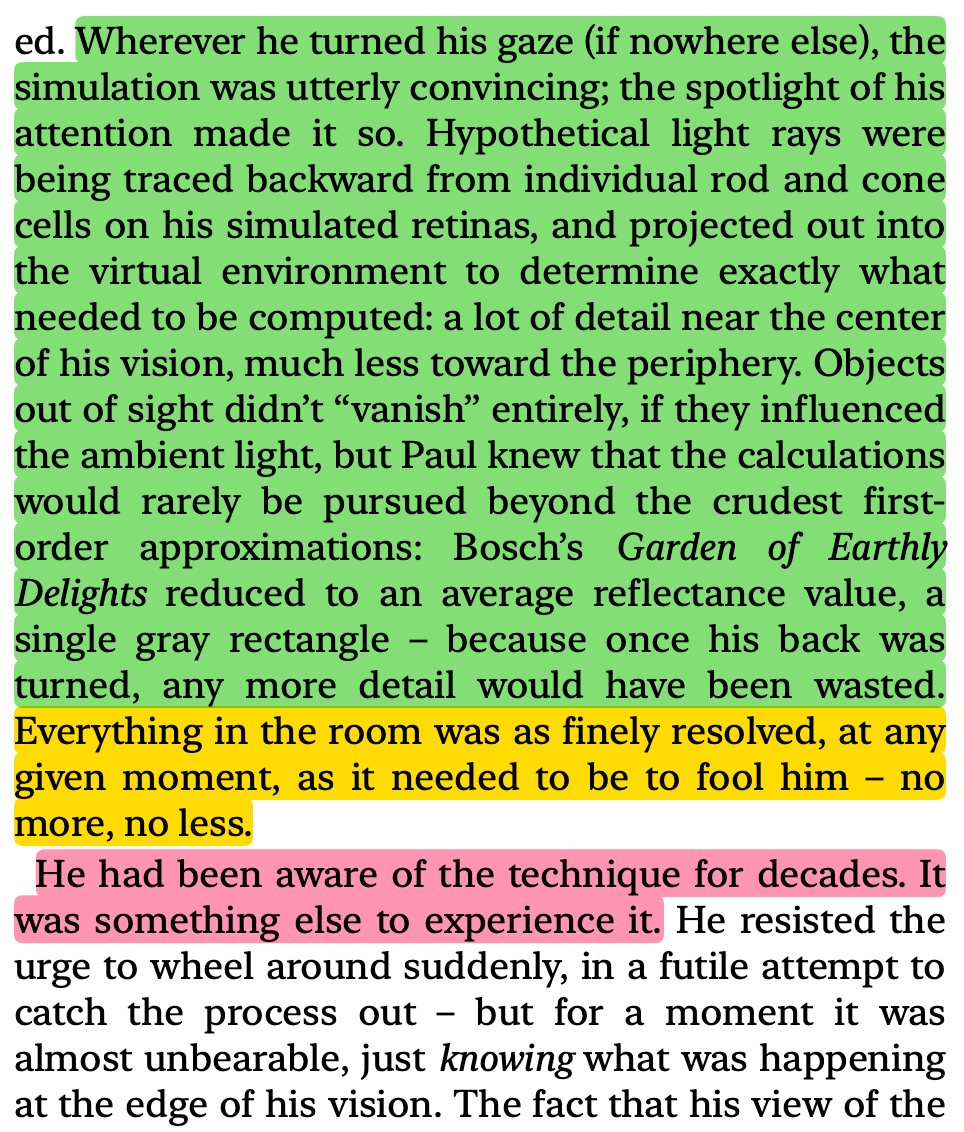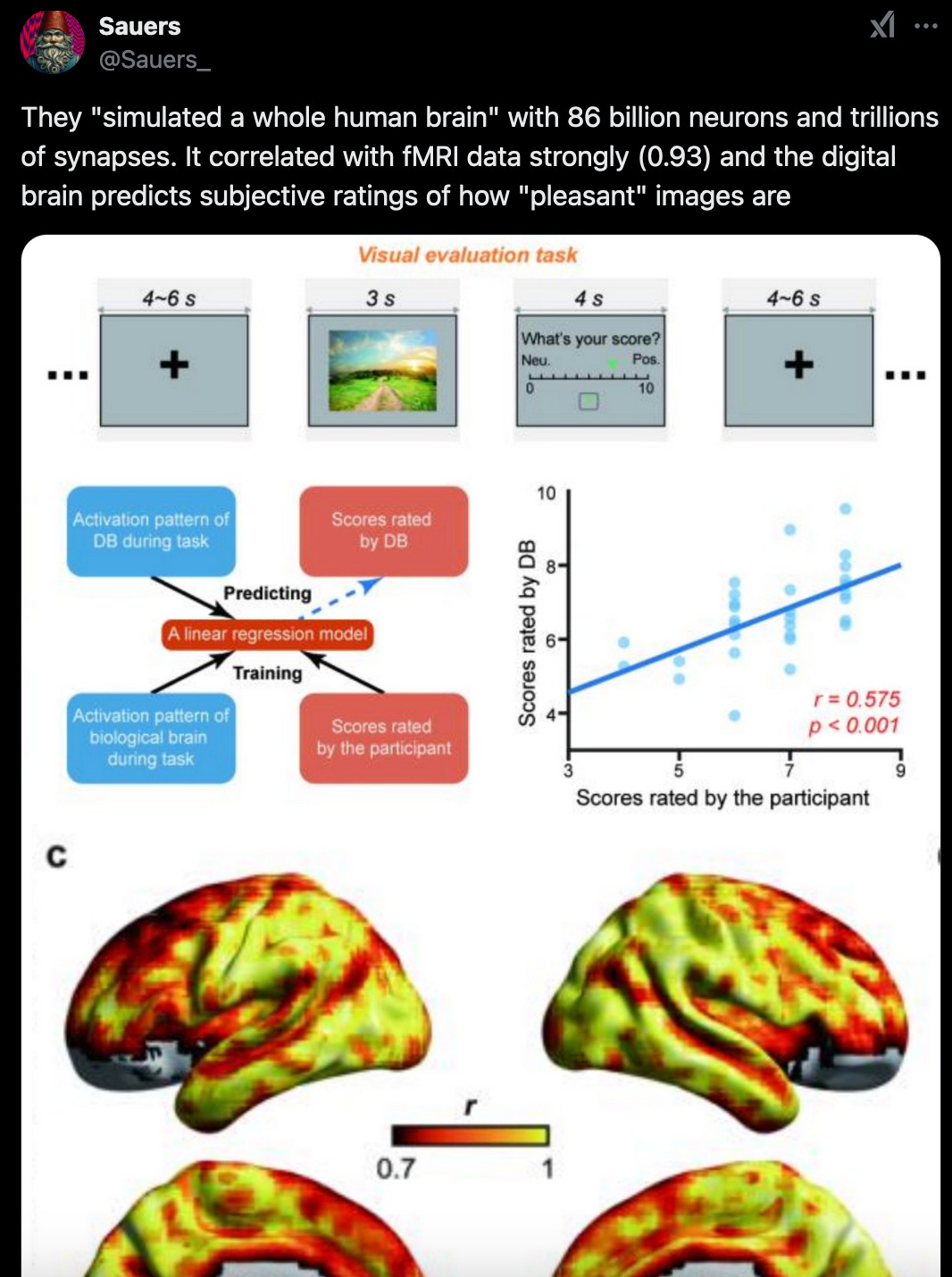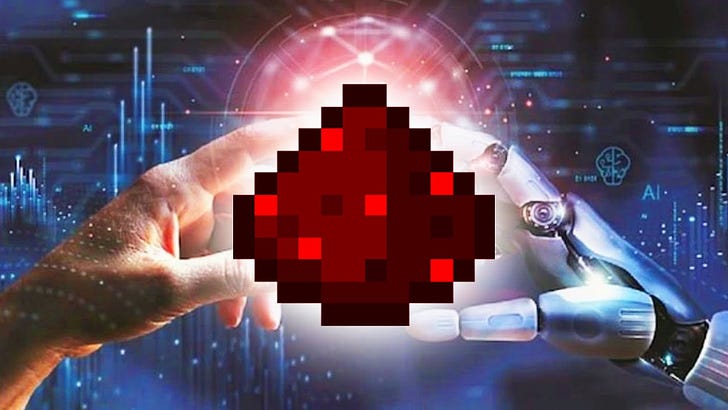Posts in this series:
Why you should think about the outcome of simulating algorithms? (Motivating the question) [0/5]
What do you get if you simulate an algorithm? (Philosophy) [1/5]
Do (modern) artificial brains implement algorithms? (AI) [2/5]
Do biological brains implement algorithms? (Neuroscience) [3/5]
The Implications of Simulating Algorithms: Is “simulated addition” really an oxymoron? (Philosophy) [4/5]
When science fiction becomes science fact (Major book spoilers!) [5/5]
Since I didn’t get to read Permutation City in 1994, I’m behind in terms of culturally experiencing that book in the milieu it was published.
But, I do think it’s nonetheless been rather interesting reading the book 30 years later. Like some other people, it has not escaped my notice that advanced tech — fusion or AGI etc. — always seem to end up being “30 years away”.

As 2024 ends everywhere on earth, I’m sure some of you are wondering how close we are to the mythical AGI, whether AI is or isn’t actually “smart” or “stupid” like humans, whether digital minds are even worth thinking about, or whether these science fiction-like ideas are “just” sci-fi and not worth taking seriously.
I wondered that too.
I can’t see the future. But what I can do is look at now, with respect to 30 years.
(For those who don’t remember, the state of tech in 1994 was roughly like this.)
So let’s have some fun and count how many things that were “science fiction” in 1994, are now science fact, not fact, or still in the process of becoming fact or fiction by today’s standards!
I’m not going to do this exhaustively because then I might accidentally quote the whole book in its entirety (a simulated copy of a book is…?). So I’ll just pick a few things that stood out to me, personally. Most of these are from the more trivial world-building parts of the book and won’t explicitly contain any of the major plot twists from the book (except the very last two, which I will signpost again when I get there).
But needless to say, everything from here on is going to be a spoiler, so if you don’t want that, come back when you’re done with the book.
5 times science fiction became fact …
1. Foveated Rendering

You could copy and paste that description from Permutation City into an explanation for how foveated rendering and ray tracing works, and you wouldn’t be too far off, honestly. (Minus the fact that the rays would be traced back to your real, actual retina). The VR headset that does foveated rendering the best right now is hands down the Apple Vision Pro, and it really is something else to experience it. Other VR headsets have tried to do it, but not as well, for various reasons.
The VR rendering isn’t as perfect as the one in Permutation City yet, but that’s just a matter of time and economics. This particular chapter was set in 2045 in the book, so we’re actually very on track even according to the timeline of the book!
2. VR training operations
People have definitely started to do this, so I put this in the fact section, but we’ve only just started. The VR is not quite as elaborate as described in the book yet, but maybe by 2045 it will be?
3. Silent Discos
Straight fact on the audio front, not quite on the visual front. But the VR hardware is out now so … whenever they become cheap enough to be widespread, it’ll happen. I wouldn’t be surprised if (when?) the next thing that makes us have to social distance brings out the VR discos worldwide!
4. Caring about where your bits are
I’m putting this in the fact section because while most people still don’t care where they put their bits (where are your cloud photos, texts, AWS containers etc. right now?), things like the debate on siloing tiktok data, the report on securing AI model weights, and bitcoin cold storage wallets show that more people are starting to care where their bits are.
Also I simply find the image of walking into my back and asking to deposit my “money” at a certain location in a particular computer’s memory absolutely delightful. I’m so tempted to actually try this one day, just to see what happens.
5. Pure observers
Judging by the abundance of newsletters, podcast, youtube channels, blogs, twitter feeds, etc. that are exactly this, I think its safe to say people like this exist, so this part is almost fact (minus the VR people part). The only question is whether the (real?) people behind the feeds spend all their time only curating information, or whether they’ve started handing off the task to AIs as soon as they could.
… 3 times it didn’t …
1. Non-invasively imaging individual neurons
Sadly by 2020, we reached the point where individual neurons can be mapped (see that fly brain paper from a few posts back), but not non-invasively. (Nearly non-invasively, though, we can!) People are looking into all sorts of non-invasive methods like photoacoustic tomography, near-infrared optical imaging and bioluminescence imaging1, but we can’t get individual neuron level data non-invasively yet.
2. A fully conscious simulation in VR in 2024
Very mixed feelings here. The curious part of me says “I want to see someone try” and the other parts of me are screaming “DON’T.”
But regardless, no one managed this in 2024. But these people sure are trying (github, preprint).

3. The ebbs and flows of human society
Is our world really so predictable that someone 30 years ago could predict what would be in the news headlines? Maybe in hindsight, things like Janurary 6th and October 7th were simply events that would inevitably happen, if you wait long enough.
…and 1 time we’re still not sure.
1. The legal standing of A.I.
The only reason this isn’t in the fact section is because Copies don’t exist yet, and so there isn’t a legal ruling on their status either way. But the debate on their legal position if they were to exist is starting to heat up. Here’s one example of a book arguing for robot rights (blog article version), an article arguing against, and a summary of common arguments for and against (though not necessarily with same arguments in the previous book or articles I linked to).
Major spoilers for Permutation City ahead!!
Now is the time to stop and come back to this post if you don’t want major spoilers for the ending of the book.
…
…
…
1. Simulated computers …
In 2024, people have actually simulated computers with computers now. Here’s one person doing it in Minecraft, and another person doing it to simulate Minecraft inside Minecraft using a computer simulating a computer. The layers of meta here boggles the mind. But if you had trouble visualizing what the characters in Permutation City were experiencing, then these videos might help.
I was curious to see if someone might simulate AI, and lo, the internet delivered. Here is someone simulating a (small) AI in Minecraft. Pay attention to how it works — where does the simulated AI differ to the “non-simulated AI” (which is the python code version of the image classifier, relative to the minecraft version of the classifier), and where does it it not differ?
Do the differences matter in the grand scheme of things?
The first thing that I got from this video was the gut understanding that the specific weights, the specific numbers making up an (artificial) neural network truly don’t matter once you’ve found a combination that works. It’s really the combination that let’s the ANN do its thing. The python version of the network might use numbers like 0.0854655, whereas the Minecraft version uses nice integers, but it will still work (subject to some accuracy trade-off.) I knew you could quantize models before, but seeing just how much you could coarse-grain things (like using that softmax substitution function) sure did hammer in that point!
The second thing is, the python version of the ANN is a simulated network, because the python ANN is not constructed with its own hardware, like this mechanical neural network. The python ANN is being simulated on more powerful hardware, like the computer that also happens to run the Minecraft game. The Minecraft ANN is a simulation of then python ANN. Both ANNs can classify written digits decently enough.
How does the relationship between the minecraft ANN and the python ANN compare to the relationship between the Wall of Wind simulator and the simulation of the Wall of Wind simulator in the previous post?
What sorts of simulands can you simulate and get back the same thing, for most intents and purposes?
What things can be copied, which will work just as well as the real thing?
(Algorithms.)
… and Mortal computation
I don’t have too much to say here for now, except that it’s a fun observational coincidence that Geoffrey Hinton started talking publicly about mortal computation and his forward-forward algorithm around 2022, ~28-30 years after Permutation City was published. Maybe there is something to the 30 year advanced tech predictions?
3. Symbolic algorithms vs. deep-learning algorithms
When I read the passage above, I was struck by much the difference between the Autoverse cellular automaton algorithm vs. the Lambertian field equations turned out to be exactly the difference between human-designed algorithms and deep-learning found algorithms.
With modular addition, humans will opt for something nice and compact to us, like:

Whereas an AliceTT learns something like this, with arbitrary frequencies w where w could be [4, 35, 41, 42, 52] or [3, 26, 34, 43] or something else (see Table 5), just like the 32 stable solutions the Lambertians happened to find.

In the end, is no such thing as “the one and only” algorithm. There are always many ways to implement the same general thing.
This is a good thing for thinking about consciousness. I can rest assured that while I know my specific brain implements one particular conscious mind (mine!), I can also know there is empirical evidence that my cat’s brain doesn’t have to implement it in exactly the same way as my brain, for me to think it is also implementing a different sort of conscious mind.
And ditto for yours.
Though, does it still count as non-invasive if you first have to edit the animal’s genes to use this method?














